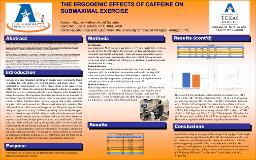
ATTENTION: The works hosted here are being migrated to a new repository that will consolidate resources, improve discoverability, and better show UTA's research impact on the global community. We will update authors as the migration progresses. Please see MavMatrix for more information.
Show simple item record
| dc.contributor.author | Kellner, Matthew | |
| dc.contributor.author | Gallardo, Angel | |
| dc.date.accessioned | 2019-04-09T23:54:04Z | |
| dc.date.available | 2019-04-09T23:54:04Z | |
| dc.date.issued | 2018-12 | |
| dc.identifier.uri | http://hdl.handle.net/10106/27942 | |
| dc.description | KINE 4400 | |
| dc.description.abstract | **Please note that the full text is embargoed** ABSTRACT: INTRODUCTION: Caffeine is a very abundant substance in society and is commonly found in coffee, tea, soft drinks, pre-workout drinks, and many others. This substance is a central nervous system stimulator which was found to improve wakefulness, thought processes, focus, and coordination. This has been used both medically and in the general public for these desirable psychological and physiological effects. Caffeine is one of the most popular substances when it comes to athletic performance enhancement and has been used for many years. The effects of caffeine on the human body has been studied thoroughly and shows that it does has a significant effect on performance enhancement during exercise. A study done by Graham and Spriet in 1991 showed a 44% increase in race-pace endurance after a heavy dosage of 9 mg of caffeine per kilogram of body weight. The caffeine dosage is a critical piece when assessing the ergogenic effects of caffeine on exercise.
PURPOSE: The purpose of this study was to determine if caffeine has an ergogenic effect on submaximal exercise.
METHODS: Five students (3 M, 2F: Mean ± age 22.2 ± 1.17 years, height 178 ± 7.83 cm, weight 70.36 ±12.32 kg) from the University of Texas at Arlington participated in this study. Participants completed two submaximal exercise bouts on a Monark cycle ergometer with the resistance set at 65% of their age-predicted heart rate max. Caffeine or a placebo was given to each participant one hour prior to their exercise bouts in a randomized order. The same resistance was used for both trials. Rate of Perceived Exertion (RPE), Heart Rate (HR), Total Distance Traveled (km), and Oxygen Consumption (VO2) (ml/kg/min) were recorded every 10 and 20 minutes.
RESULTS: The values for the placebo trail at ten minutes of exercise were: RPE =12.8+1.10; HR =152.80±20.01 (bpm); VO2 = 22.12±6.81(ml/kg/min), and at twenty minutes: RPE =13.80±1.30; HR =154.4+20.01 (bpm) and VO2 = 20.90+5.85(ml/kg/min). The values for the caffeine trail at ten minutes of exercise were: RPE =13.2±.84; HR
=151+17.99(bpm); VO2 = 21.7±5.31(ml/kg/min), and at twenty minutes: RPE =14.4±1.67; HR =156.2±12.42 (bpm); and VO2 = 22.14±7.74 (ml/kg/min). The values for total distance were: caffeine 9.24±2.52 km and placebo 8.08±1.69 km. There was no significant difference in any values between trials.
CONCLUSIONS: The findings of this study showed that there was no significant difference when taking caffeine or placebo during a submaximal exercise test as measured by RPE, HR, Total Distance Traveled, and VO2 (ml/kg/min). However, on average the total distance during the caffeinated trials was increased compared to the placebo trials. | en_US |
| dc.description.sponsorship | Faculty Sponsor: Judy R. Wilson | en_US |
| dc.language.iso | en_US | en_US |
| dc.publisher | The University of Texas at Arlington | en_US |
| dc.subject | Ergogenic effect | en_US |
| dc.subject | Caffeine | en_US |
| dc.subject | Submaximal exercise | en_US |
| dc.title | The Ergogenic Effects of Caffeine on Submaximal Exercise | en_US |
| dc.type | Presentation | en_US |
| dc.publisher.department | Department of Kinesiology | |
Files in this item
- Name:
- Gallardo Kellner Poster.pdf
- Size:
- 698.4Kb
- Format:
- PDF
- Description:
- PDF
This item appears in the following Collection(s)
Show simple item record


